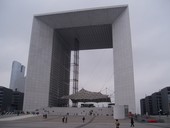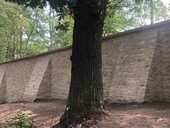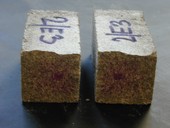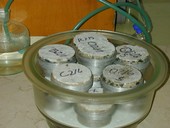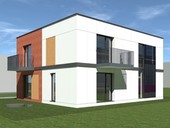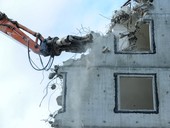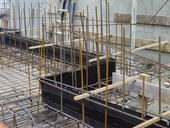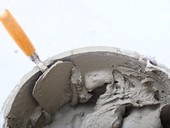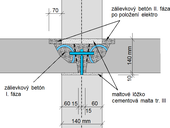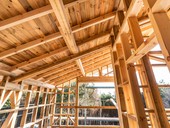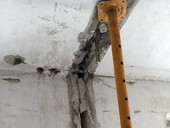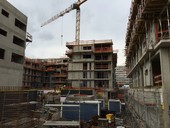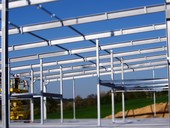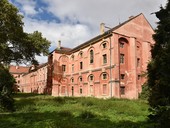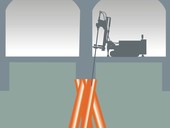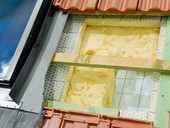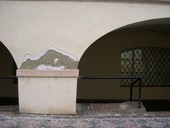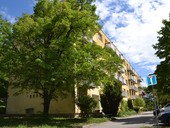Article follows the previous general treatise concerning prestressed steel compression tubes with just one crossarm (Machacek [1]). This article deals with tests of stayed columns, numerical analyses and their evaluation. In the theoretical part the linear bifurcation analysis (2D LBA) to establish critical loads and buckling modes is presented, the geometrically nonlinear analysis to establish strengths of imperfect stayed columns (3D GNIA) and also the geometrically and materially nonlinear analysis to establish strengths of imperfect stayed columns made of stainless steels (3D GMNIA) are introduced. Numerical calculations employ software ANSYS and are validated by tests. Parametrically are investigated impacts of initial deflections, directions of buckling, material nonlinearities and the technique of the stays supports at crossarms. Results are summarized into practical recommendations.
Archiv článků od 16.12.2019 do 7.9.2020
The aim of the study was to determine the functional reliability of the historic wall of the Hvězda summer house and to assess its applicability. The article presents the possibilities of freestanding wall renovation design using optimal technologies, analysis of solution proposals and evaluation of risk factors. The actual design of the renovation was preceded by a detailed structural survey. At the end of the article, the course of implementation work is described, including the selected material solution of restoration. The Klokner Institute of the Czech Technical University participated in the material analyses and the renewal proposal was consulted with the National Heritage Institute.
Carbonatation of concrete (or possibly of cement grout) is a slow destructive process, which continuously causes the change of pH, the corrosion of reinforcement, up to the total loss of strength and cohesion of concrete. It seems, however, that the carbonatation process can be partially influenced by a composition of concrete mixture and by perfect dumping. Greater batches of cement, preferably portland cement, guarantee the best natural preservation of concrete. On the contrary, negative effects of carbonatation demonstrate themselves stronger in the worse dumped concrete and also in concrete with excess of batching water. Finding a suitable recipe for a concrete mixture together with a perfect processing technology lead to a significant prolongation of lifetime of concrete constructions exposed to invasive action of gaseous carbon dioxide.
The addition of structural fibres to concrete has a positive and negative impact on the long-term life of concrete. Polymer fibres, given their low flexibility module, do not always help the concrete to sustain its diverse deformations. Steel fibres on the other side create a hard skeleton to prevent varied deformation, but with the possibility of negative separation of cement paste from fibres. The state of the pore structure of fibre concrete exposed over a long period of time in the CO2 environment can be detected using the method of determining the diffuse resistance coefficient and alternatively the method of determining the capillary elevation. During the process of long-term carbonation of fibre concrete, significant changes occur in the observed values of both physical quantities -- that is, the diffuse resistance coefficient and capillary elevation.
The concept of sustainable development is becoming increasingly popular worldwide. The intensive debate on sustainability issues in the construction industry has led to the development and implementation of various systems for defining and assessing the sustainability of buildings around the world. Concrete is one of the most important and useful materials in the construction sector, which, unfortunately, has an adverse impact on the environment, it is evident that correct procedures for designing concrete structures need to be created. In this paper is an indicator expressing quality, with regard to sustainability, is determined using information on concrete performance characteristics, service life and environmental impact, enabling the quantification and comparison of various cases.
White tanks are structures which, in addition to the load-bearing function, must also have the function of watertightness. Watertight of the concrete is ensured by adherence to design, production and technological measures. The width of the early-age cracks that former in the structure is controlled by the reinforcement. During construction, however, joints (expansion, construction and control) are created in the structure, which must also be watertight. The joints are the most sensitive place of the white tank and therefore the most leaks are created at the point of the joints. The correct choice of the joint sealing system is the basis for the design of the watertight joint. The paper deals with the description of various joint seal and pipes through of the white tank.
One of the main characteristics in the concreting of massive, waterproof and dam structures is the prediction of crack formation. This prediction is connected with the understanding of mechanism hydratation temperatures development in concrete that affects in particular the selected parts of binder. Suitable combination of cement and mineral admixtures, as well as the usage of shrinkage reducing admixtures appears to be an effective tool for influencing the dynamics of development and maximum values of hydration temperatures. Appropriate selection of the concrete formulation can significantly extend the mentioned structures lifetime.
The article is focused to a monitoring of influence of different mineral admixtures on influence of volume changes of cement pastes. Furthermore, in this article was monitored connection between volume changes and hydratation temperatures development of cement pastes. With the target of minimalization both these phenomena were used shrinkage reducing admixture.
The mass construction of apartment buildings using the technology of large-format prefabricated prefabricated elements in the former Czechoslovakia took about 40 years. The lifetime of these buildings is approaching their planned value. A common problem of prefabricated buildings is the creation of new openings in load-bearing structures without prior expert appreciation. The important details of the joints of the support elements have changed not only between the individual assemblies, but also during the development of the particular assembly. The article describes some problems of load-bearing structures of prefabricated buildings, which designers have to consider in their assessment.
This paper is a theoretical research of semi-rigid timber connections using modern fasteners Rothoblaas Alumidi. These connectors allow for semi-rigid behaviour. The aim of the research is the examination of the real behaviour of structural connections with real constants of rigidity. The rotational stiffness is calculated according to [1] and it is verified by the method of deflection of virtual bending moment. The results of the numerical calculation will be confronted with experimental verification of the connections. Concurrently with the experiment, the axial loaded grip nails will be examined in order to determine the value of slip modulus.
The construction of precast hous consists of prefabricated concrete walls and floor slabs. These elements through joints form rigid spatial (so-called box) load-bearing system. The prefbricated elements of this system were designed for certain layout and static possibilities of the panel system. All additional interventions in the load-bearing structure must be thoroughly investigated. If necessary, it is also necessary to propose a suitable way of strengthening the weakened parts of the load-bearing system.
This article is focused on current situation in preparation of new generation of European standard for design of concrete structures prEN 1992-1-1. This article deals with main features and development in design principles involved in new standard. In these days there is available the 4th draft of standard for comments of national authorities and experts. The final draft of prEN 1992-1-1 should be finished this year (2020) and provided to formal vote in CEN.
Eurocodes EN 1991 for the basis of structural design and EN 1991 for actions, currently under development in the Technical Committee CEN/TC 250, should be more user-friendly in the 2nd generation of Eurocodes. They will provide basic design procedures, new types of actions and improved theoretical models which will be applied for the design of structures. For effective and economic implementation of 2nd gneration of Eurocodes into the systém of Czech standards, correct decision on National Determined Parameters is needed.
The article presents the basic criteria in the evaluation of structures of historical buildings. The whole procedure is described in detail in EN 13822, Annex I. The intention is also to provide additional guidance on the application of this International Standard for the construction of cultural heritage buildings. The instructions given here are to be followed in conjunction with all other clauses of the internationally applicable standard EN 13822 and other regulations.
The paper deals with the constructions from jet grouting (JG), which is one of the most modern methods of special geotechnical works. JG is the technique of mixing in-situ soil with the energy of high-pressure jet of slurry. The definitions and types of JG are given in the first part: single fluid, double fluid and triple fluid. The second part concerns JG implementation technology and also lists the necessary activities in designing and implementing JG elements and structures. In the third part, examples show the field of use of JG, including deep foundations, for which the example of static load test is given.
In this paper, the authors consider the aspects of routine procedure compared to the expert approach in solving construction defects and failures. For better orientation in the issue the basic terminology of defects and failures sphere is given. Also, the authors describe in details the course of both solutions, contemplate their specific aspects and point out their consequences. An essential part of the article is presentation of the potential benefits of the expert approach, the advantages of the expert approach are emphasized in the conclusion.
The paper discusses the importance of water absorption of traditional building materials and the ability of traditional non-insulated buildings to withstand rising damp. It also draws attention to some of the risks involved in reducing the water absorption of building materials designed for remediation of moisture and salts problems of traditional buildings.
Oak dowels find its use in carpentry joints, reconstructions of buildings and, also, dowel-joined CLT panels put together without adhesives. The article deals with influence of manufacturing techniques and shape of the cross-section on the bearing capacity of the dowels. Round shape (turning and perforation through steel hole) and hand hawing to the octagonal shape was tested. The results show negligible influence of manufacturing techniques on studied quantity.
The paper presents the results of experimental analysis and an analytical model describing the behavior of racking shear walls made of mechanically joined cross laminated timber. Tests of wall panels, tests for determination of stiffness of layers’ joints and material tests were carried out as part of experimental analysis. Outputs from the layer stiffness tests and material tests are used as input data for the analytical model. The analytical model is based on a component method that considers a wall panel as a system of interconnected elements. The action of the elements is described by springs with defined stiffness. The results of the experiments and the analytical procedure are then compared with each other.
zpět na aktuální články
